WMG News - Latest news from WMG
Mura Technology and WMG secure innovate UK grant to grow commercial opportunities for Hydrothermal advanced plastic recycling technology
WMG at the University of Warwick, Innovate UK (IUK) and advanced recycler of plastics Mura Technology are to continue their collaboration on sustainability with a new IUK funded, two-year Knowledge Transfer Partnership (KTP).
WMG will develop operational sustainability models for Mura’s Hydro-PRT advanced plastic recycling technology to identify opportunities for further improvements to the already sector-leading environmental performance of the process. Mura has already identified an annual carbon emissions saving of 40,000 tonnes at the first Hydro-PRT site in Wilton, Teesside, due to commence operations in 2024.
 Mura Technology is an advanced recycler of waste plastics, producing fossil-equivalent oils from post-use, mixed, multi-layered flexible and rigid plastics for the petrochemicals industry to create virgin-grade plastics, such as for use in food packaging. Mura's patented, innovative next generation processing technology, Hydro-PRT, produces high quality chemicals and oils with sector-leading sustainability attributes, creating a low carbon and circular model for a range of stakeholders working with polymers.
Mura Technology is an advanced recycler of waste plastics, producing fossil-equivalent oils from post-use, mixed, multi-layered flexible and rigid plastics for the petrochemicals industry to create virgin-grade plastics, such as for use in food packaging. Mura's patented, innovative next generation processing technology, Hydro-PRT, produces high quality chemicals and oils with sector-leading sustainability attributes, creating a low carbon and circular model for a range of stakeholders working with polymers.
The company's first commercial scale plant, at Wilton, Teesside, will become the world's largest advanced recycling plant when it commences operations later this year, with two further plants being built under licence with partners in South Korea and Japan, expected to come online by the end of 2024. Driven by increasing regulation on plastic waste, Mura has a global growth ambition for more than 1.5 million tonnes of recycling capacity in operation or development by 2032.
WMG will create a modelling platform that will operationalise sustainability at all future Mura project sites, including Life Cycle Assessments (LCAs), to demonstrate transparently how Hydro-PRT meets environmental requirements. The platform will be used to educate and inform stakeholders including global regulators, policy makers and the plastics value chain on the low carbon potential of
Hydro-PRT.
The KTP is the continuation of the IUK Smart Sustainable Plastic Packaging research partnership, where Reader of Sustainable Materials and Manufacturing at WMG, University of Warwick, Dr Stuart Coles successfully developed and published Life Cycle Analysis models, independent of Mura, for the Hydro-PRT process and the UK waste plastic recycling ecosystem. Dr Coles will also be the academic lead on this project.
Simon Broome Innovation Manager at WMG, University of Warwick, who co-wrote the application for the project, said: “I was blown away by the potential of this project to transform the process for recycling contaminated waste plastic. The team are highly committed and have already demonstrated impressive growth on their journey to make real sustainability gains in this important material sector.”
Mura’s Head of Sustainability and R&D, Dr Geoff Brighty, said: “Continuing the collaboration with WMG is critically important to bring this new science into our core business operation. Hydro-PRT has sector leading sustainability credentials, but every prospective site will be unique, influenced by the local energy grid, plant configurations as well as its material supply chain. The KTP project models will inform options appraisals and decision making, ensuring sustainability is at the heart of our global growth programme.”
For more information on developing a Knowledge Transfer Partnership application with WMG, contact wmgsme@warwick.ac.uk
For more information on WMG’s research in Sustainable Materials and Manufacturing visit: Sustainable Materials and Manufacturing Group (warwick.ac.uk)
Inspiring the next generation of engineers
 WMG at the University of Warwick's commitment to widening participation and fostering inclusivity took centre stage during a week-long work experience programme, aimed at inspiring local students to pursue a career in engineering.
WMG at the University of Warwick's commitment to widening participation and fostering inclusivity took centre stage during a week-long work experience programme, aimed at inspiring local students to pursue a career in engineering.
The initiative was organised by WMG’s Outreach team and the University's Widening Participation Team to support under-represented students that might lack confidence or support when they consider a future in engineering. The High Value Manufacturing Catapult’s Inspiring Young Engineers project, which delivers engaging opportunities to students who might not otherwise have experienced the subject, also supported the week.
Throughout the programme, participants were mentored by WMG staff who provided valuable insights into various engineering pathways, research and careers.
Tours of the engineering facilities showed what research at a university is like - from battery development in the Energy Innovation Centre and automotive technology in the National Automotive Innovation Centre, to studying for an engineering degree at the School of Engineering.
The WMG Outreach Team also worked alongside colleagues from the University’s Creative Arts department who organised an arts-focused work experience programme to run at the same time.
The programme concluded in a celebration showcase where the students, from both the arts and engineering teams, presented their work to parents, carers, teachers and University staff, including the Vice Chancellor Professor Stuart Croft.
teachers and University staff, including the Vice Chancellor Professor Stuart Croft.
Reflecting on the programme, WMG’s Widening Participation Co-ordinator, Dr Phil Jemmett, said: “We ran this event last year with the support of the University’s Widening Participation team and immediately thought that we could scale this up, and share the model with a wider group.
“We are delighted to have had the Creative Arts stream on board because it shows how different skillsets and expertise is needed to create solutions that will actually benefit people. I’m proud to have been able to give young students an experience of how collaboration really happens.
“Throughout the week we’ve had ups and downs, challenges and successes – but that is what engineering is really like! Nothing works the first time, so the students have had to learn problem solving and resilience. I couldn’t have been happier to see all six projects from the engineering stream up and running at the final showcase – what’s more each one of them had elements and decisions devised by the students themselves.
“They have all grown in their abilities and confidence, and I hope that they take that confidence back with them to their studies, and future careers.”
This year’s programme follows the mission statement of the 2023 event, but with the addition of creative arts: “The University of Warwick's initiative reflects its dedication to providing equal opportunities in engineering and creative arts education. By empowering less privileged local students and challenging misconceptions about the subjects, they are nurturing a diverse talent pool that will shape the future of engineering and creative arts.”
The event was supported by a host of staff and student ambassadors including Phil Jemmett; Margaret Low; Caroline Cannon; Marie Diebolt; Alex Band; Bruce Guild; Megan Clement; Robin George; Harry Gillions; Liv Griffiths; Martin Hill; Myles Ing; Karen Kudar; Samuel Leo; Zarin Miah; Ihsan Muhaddisoglu; Umair Paracha; Bradley Peirce; Adam Rich; Shawon Shanto; Elizbieta Titis; Jingyi Zhao; Caroline Cannon; Gauri Verma; Oksana Trushkevych; Bill Crofts; Richard Carney; Vidya Narayanan; Bradley Pierce; Laura Copland; Jay Carter; Paul Philipson; and the WMG Facilities team.
Find out more about WMG's Outreach programme here: Outreach and Widening Participation (warwick.ac.uk)
The University of Warwick celebrates 200 engineering internships in manufacturing to mark National Manufacturing Day
The University of Warwick is celebrating a new milestone for its engineering internship scheme, with over 200 internships now completed.
The milestone will be celebrated at a special event tomorrow on campus to mark the UK’s National Manufacturing Day – Thursday 28th September.
The internship scheme, which was established by the University’s WMG in 2013, places students in engineering internships at manufacturing businesses across the Midlands.
The scheme has been a hit with both students and businesses, with 75% of businesses experiencing increases in productivity and 95% saying they had noticed a positive cultural change thanks to the interns.
Most businesses who hired one intern through the scheme returned in the future, with around 70 interns now having been offered full time positions as a result of their internships.
The scheme was established to address the skills gap, with businesses needing more engineers than are available. Research suggests this gap is likely to get worse as demand increases, particularly for ‘green’ engineering roles.
Febry Wardhana, an Engineering Project Management postgraduate, recently completed his internship at Midtherm Flue Systems. They were so pleased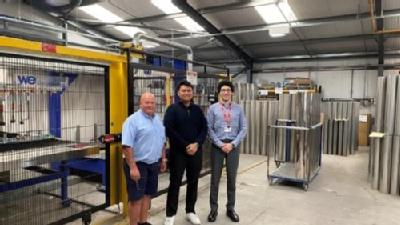 with his work Febry now works for the company permanently.
with his work Febry now works for the company permanently.
Michael Whale, Midtherm’s Training and Development Manager said: “Febry’s work has opened up a lot of new doors for us and he has done a great job, so much so that we offered him a full-time position as a process engineer.”
Other interns have gone into a range of high-profile roles in both small and large organisations. Warwick graduate Sam Woodcock who undertook an internship at Pashley Cycles is now working at Arup as a mechanical engineer. He said:
“My internship with WMG and Pashley helped me to become comfortable in not knowing the answer to every problem I faced, and therefore taught me how to persevere and overcome engineering challenges.”
Dr Mark Swift, Director of SME Engagement at WMG commented:
“Our internship programme is hugely important for us. It has supported over 200 manufacturers while tackling a range of important projects in their businesses and proves that young engineers can add real value. It is critical that we kick start the careers of our future engineers so that they can get onboard to deal with the manufacturing challenges of both today and tomorrow.”
New Chief Technology Officer appointed at the WMG centre for High Value Manufacturing Catapult (HVMC)
WMG centre for High Value Manufacturing, at the University of Warwick, has welcomed its new Chief Technology Officer (CTO), Simon Webb.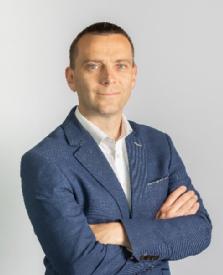
Simon, who was previously Head of Zero Carbon Strategy for the Aerospace Technology Institute (ATI), has over 20 years’ experience in aerospace engineering, technology and strategy leadership.
Prior to this, he was the Chief of Technology and Digital (Civil Aerospace) at Rolls-Royce, responsible for a portfolio of technology strategy and execution programmes globally.
Simon has a background in leading the development, design and manufacture of aerospace engines including the engineering teams on the world’s most efficient large aero-engine, the Trent XWB, and more recently the Rolls-Royce Titanium-Composite Fan System development activity.
He also sits on the board of directors for the JetPerfect Foundation, focusing on zero carbon flight technologies; and the technical advisory board of the ENABLE-H2 hydrogen research programme led by Cranfield University.
With his extensive industrial and technical background, Simon will help continue WMG’s work to accelerate new concepts in manufacturing into commercial reality, helping businesses tackle challenges with innovations in technologies, processes and materials.
Simon Webb comments: “I’m delighted to be joining WMG as Chief Technology Officer and by extension being part of the University of Warwick. I’m looking forward to further developing and applying the technologies and capabilities WMG has to offer into industry, and in doing so improving the sustainability of our transportation network and beyond. I expect to work closely across the High Value Manufacturing Catapult network to integrate our capabilities and so maximise the benefits to industry, the UK, and our global partners.”
Professor David Greenwood, CEO of WMG centre High Value Manufacturing Catapult says: “We are delighted to welcome Simon to the team. He brings with him a wealth of experience in aerospace and digital manufacturing, centred around zero carbon propulsion. Simon’s aerospace expertise broadens our depth of knowledge at WMG, and we are looking forward to learning more from him.”
Professor Chris Dungey, High Value Manufacturing Catapult CTO, says: “Simon is joining the HVMC family at an exciting time. We are entering a new chapter which will see the Centres across the network working more collaboratively than ever before, and I am looking forward to working with Simon and the wider CTO team to help the Catapult deliver industrial transformation for the UK.”
Find out more about the High Value Manufacturing Catapult centres here: https://hvm.catapult.org.uk/
Project launched to deliver the next generation of sustainable electric motors
 WMG, at the University of Warwick, is playing a key role in the UK-ALUMOTOR consortium working to build on the UK’s electric motor supply chain by leveraging manufacturing expertise to deliver the next generation of sustainable electric motors.
WMG, at the University of Warwick, is playing a key role in the UK-ALUMOTOR consortium working to build on the UK’s electric motor supply chain by leveraging manufacturing expertise to deliver the next generation of sustainable electric motors.
The consortium, led by Ricardo, will deliver a tested and validated pre-production, highly sustainable motor, with up to 12kg reduction in rare earth magnets per machine. This will enable the UK to scale motor production and accelerate the transition to electrified transport, as well as build and secure its national capability and domestic supply chain without risk from international markets, so providing competitive advantage.
The consortium is also investigating higher performance derivatives, suitable for passenger cars, defence and motorsport applications.
WMG’s role as the project’s stator integration lead is to use the DER Winding Centre of Excellence to help build several novel synchronous reluctance e-machine prototypes, helping to develop a range of manufacturing processes to pre-production level for the pre-production design. Engineers and researchers at WMG will conduct process development and components testing, leveraging work on earlier APC funded projects, to advise the partners on design for manufacture, bill of processes, and end of line testing to provide a viable manufacture solution.
Funding for the project has been awarded by UKRI’s Driving the Electric Revolution and will allow the consortium to take the light commercial vehicle motor concept to a much higher level of manufacturing readiness.
This two-year project builds on previous successful collaboration between the consortium in 2021 as the UKRI funded feasibility study was delivered. WMG has supported the design since its inception through earlier DCR project with Ricardo in 2020.
Teri Hawksworth, President of Ricardo Automotive and Industrial EMEA, said: “The cost of electrification is widely recognised as being the biggest barrier to wide-scale adoption of electric commercial vehicles. Manufacturers are also concerned about the supply security and volatile costs of the rare earth metals used in most zero emission vehicles. Ricardo is committed to supporting manufacturers by driving cost out of electrification, leveraging our world-renowned expertise in motor innovation, and driving sustainable technology solutions which will support the UK in achieving its net zero carbon emission targets for commercial vehicles by 2030.”
David Simkin, Head of the DER Winding Centre of Excellence (WCE), said: “The challenge of taking a novel topology of eMachine to early stage production is exactly what the DER WCE facility was designed to deliver. Taking the experience and knowledge gained in the earlier UK-ALUMOTOR program to early phase manufacturing will build on the manufacturing process and training skills already at WMG. Manufacturing of eMachines in the UK is necessary to move to a zero emissions outcome in the UK. It is the priority of the WCE to support UK manufacturers and UK supply chain companies to satisfy this market opportunity in electrification, and this project provides a perfect opportunity for us to do this.”
In addition to consortium leader, Ricardo, the project consortium partners include: Aspire Engineering, Brandauer, WMG, Phoenix Scientific Industries, and Global Technologies Racing.
Find out more about WMG’s Transport Electrification research here.
Mayor opens Ramfoam’s new headquarters as company embraces digital thanks to WMG, University of Warwick
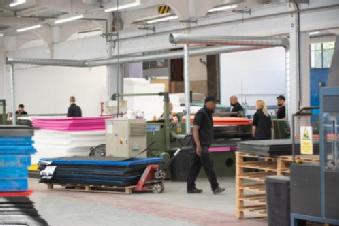
One of the first companies to sign up to a programme to improve the digital capabilities of smaller businesses has officially opened its new company headquarters and factory in Sandwell.
Andy Street, Mayor of the West Midlands and chair of the West Midlands Combined Authority (WMCA) cut the ribbon at Ramfoam’s new site on Haigne Road, Tividale which will see the business increase in size by 50 per cent.
Ramfoam, which makes foam products for the military and other organisations, was one of the first businesses to sign up to the West Midlands Made Smarter programme which is aimed at increasing the number of small and medium-sized enterprises (SMEs) adopting digital technology in manufacturing. Last year Ramfoam adapted its manufacturing practices to produce two million face visors a week at the height of the COVID-19 pandemic.
Made Smarter, which was officially launched in June, is headed up by the WMCA and the Department for Business, Energy and Industrial Strategy (BEIS).
Andy Street, the Mayor of the West Midlands said: “The West Midlands is a shining light for UK innovation, and that has become even more apparent throughout the pandemic.
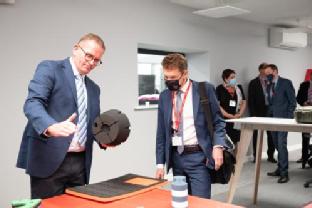 “That’s why, in partnership with BEIS, we set up the Made Smarter programme to help SMEs really make the most of our region’s digital capabilities.
“That’s why, in partnership with BEIS, we set up the Made Smarter programme to help SMEs really make the most of our region’s digital capabilities.
“It is therefore brilliant to see companies like Ramfoam not only taking part in the programme, but also the transformative effective it has had with their new expansion. The more companies that prosper like Ramfoam, the more jobs we’ll be able to create for local people.”
So far 85 companies have asked to join Made Smarter West Midlands and 58 have started the first stages of the programme. The year-long £1.9 million programme will see digital experts provide advice to businesses - like Ramfoam - on how to switch to advanced and automated technologies as well as working to improve employees’ overall digital skills.
Tim Mulqueen, Ramfoam’s sales director, said: “The Made Smarter programme is greatly assisting SMEs with their invaluable experience. Ramfoam is now actively working with Made Smarter to apply digital technologies to our business that will enable us to manufacture smarter and improve our efficiency, and in turn generate growth.
“I believe all West Midlands SME businesses could greatly benefit from support through Made Smarter; we all as SMEs need to challenge the way we do things in order to continuously improve and innovate.”
Ramfoam was helped by WMG at the University of Warwick to scale up production from 100,000 to two million face visors a week for the Government at the height of the pandemic.
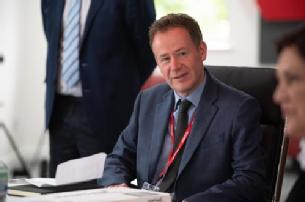 By creating a digital twin (a virtual model) Ramfoam was able to make 54 million visors over the last year. The company also signed up for WMG’s help to creating digital visualisation of its new factory, and now, as one of the first participants in Made Smarter West Midlands, will benefit from further assistance in adopting digital technology further.
By creating a digital twin (a virtual model) Ramfoam was able to make 54 million visors over the last year. The company also signed up for WMG’s help to creating digital visualisation of its new factory, and now, as one of the first participants in Made Smarter West Midlands, will benefit from further assistance in adopting digital technology further.
Dr Mark Swift, head of SME programmes at WMG, University of Warwick commented:
“The pandemic was a tough time for any business, and being able to flourish during it is certainly an achievement that Ramfoam has been able to do. We thoroughly enjoyed helping them drive up productivity and look forward to helping to transform Ramfoam further.
“It is incredibly exciting to see a West Midlands manufacturer doing so well, and we hope that more businesses will sign up to Made Smarter and continue to make the West Midlands a thriving manufacturing hub.”
The Coventry and Warwickshire Local Enterprise Partnership (CWLEP) Growth Hub is leading the one-year Made Smarter scheme with the region’s other Growth Hubs in Greater Birmingham and Solihull, the Black Country, Worcestershire, The Marches, and Stoke-on-Trent and Staffordshire on behalf of the WMCA and BEIS. The Growth Hubs are working closely with the WMCA and their strategic partners WMG, at the University of Warwick, and the Manufacturing Technology Centre (MTC) in Coventry.
Craig Humphrey, managing director of the CWLEP Growth Hub, said Ramfoam is a great example of a company best placed to take advantage of the Made Smarter scheme.
He said: “It’s fantastic that Ramfoam is one of the first firms to become part of the Made Smarter programme here in the West Midlands. It will help firms like Ramfoam develop innovative technology for the benefit of the region, as well as adopting new technology themselves to improve efficiency.
“Made Smarter will enable SMEs across the West Midlands receive the specialist support they need to embrace digital technology, and we are looking forward to more companies applying to Made Smarter and following in Ramfoam’s footsteps.”
Cllr Ian Brookfield, WMCA portfolio lead for economy and leader of City of Wolverhampton Council, said: “SMEs have felt the effects of the pandemic and have had to adapt to different ways of working as demonstrated by Ramfoam.
“Improved digital expertise gained through Made Smarter can help the region’s SMEs future-proof their practices, contributing to the economic prosperity of the region.”
To find out more about Made Smarter visit https://www.cwgrowthhub.co.uk/made-smarter-west-midlands
WMG professor to lead research and network strand for £147 million Made Smarter Innovation programme

Recognised for her expertise in supply chain design and strategy, as well as process improvement and sustainability, Jan Godsell, Professor of Operations and Supply Chain Strategy at WMG, University of Warwick, has been appointed as a co-director of the research and network strand within the £147 million Made Smarter Innovation programme.
Taking on the UK Research and Innovation role with immediate effect, Professor Godsell will be working with the Economic and Social Research Council to lead the research and network strand of the programme alongside fellow newly appointed co-director Jillian MacBryde, Professor of Innovation and Operations Management at the University of Strathclyde.
Together they will look to expand the stakeholder community and research into a Made Smarter Network Plus on an initial five-month agreement working alongside the Challenge Director and programme team.
The Made Smarter Network Plus aims to bring together insights across the wider UK manufacturing sector, bolstering digital technology innovation opportunities in manufacturing through engagement and collaboration.
Commenting on her new role, Professor Godsell said:
“The scope for improving the flexibility, sustainability and productivity of the UK manufacturing sector is huge, so I was keen to take this role to partner with Jillian on introducing research and new ideas to the industry.
“Introducing these important external influences in an effective way will require a deep understanding of the specific needs and demands on the manufacturing sector, which I hope I can bring to the Network Plus model to ensure it thrives for the benefit of all involved.”
Professor Godsell provides advice on strategy and activity across government and industry as part of her existing roles on various supply chain groups, including the Department for Business, Energy and Industrial Strategy Supply Chain Resilience Advisory Group.
Chris Courtney, Challenge Director for Made Smarter Innovation, said:
“Digital technologies have the power to radically transform how we manufacture and deliver the products and services of the future and deliver a more resilient, prosperous economy with fundamental changes to the nature of work.
“A key part of delivering an optimal future in manufacturing will be enabled by harnessing the insights from the broader economic, social, regulatory and political sciences.
“I’m delighted to welcome Jan and Jill to the overall effort as co-directors, combining two of our leading academics in this space bringing leadership, insight of with a passion for manufacturing.
“I’m excited to get this work underway and to support Jill and Jan as they reach out to the broad network of capability to engage and shape a vital and exciting programme of work.”
Register for the upcoming Made Smarter Network Plus Townhall Event on 13th May here to find out more about the programme and how to get involved.
Digital supply chain visibility needed to rebuild after COVID-19
Manufacturers must unlock supply chain visibility to rebuild after the COVID-19 pandemic, WMG and Blue Yonder are warning.
The pandemic has disrupted supply and demand in many ways, from factory and border closures to swings in consumer needs, and those without supply chain visibility have been struggling to adapt and keep up. Digital supply chain technologies perform a vital role across all stages of manufacturing, from sourcing materials and quality control to warehouses and shipping. Now the industry is being warned any talk of ‘building back stronger’ won’t come to fruition if manufacturers don’t have the visibility over demand and supply that digital supply chains can bring.
The warning comes as a result of WMG research conducted in with almost 250 manufacturing companies revealing that lack of visibility and workforce issues are creating the biggest supply chain bottlenecks:
- 47% cited lack of visibility of capacity at suppliers and 37% cited lack of visibility of demand from customers as major supply chain constraints.
- More than half (55%) used inventory as the major buffer against disruption. This ties up cash and can leave organisations exposed if demand falls.
- Less than a third (32%) used visibility in their supply network to react to disruption. This is potentially a more effective strategy in the longer term.
To help manufacturers assess their supply chain needs, WMG at the University of Warwick and Blue Yonder worked together to design a freely accessible digital readiness tool. The digital readiness tool gives manufacturers the ability to assess their current supply chain to see where they are now and where they need to be. Manufacturers can also enquire about a further consultation to understand what they need to do to get to their goal and survive in the post COVID-19 world.Professor Jan Godsell, WMG, University of Warwick
Professor Jan Godsell, from WMG, University of Warwick, comments: “As we continue to deal with the disruptions of COVID-19, demand and supply visibility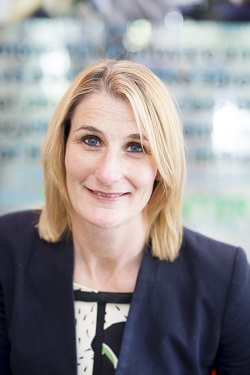 has never been more critical. It enables manufacturers to better plan their manufacturing operations, to minimise costly inventory buffers. We hope that the supply chain digital readiness tool can assist manufacturers with identifying opportunities to use digitisation to help their businesses to survive and thrive amidst the challenges of COVID-19. We are also offering manufacturers further advice.”
has never been more critical. It enables manufacturers to better plan their manufacturing operations, to minimise costly inventory buffers. We hope that the supply chain digital readiness tool can assist manufacturers with identifying opportunities to use digitisation to help their businesses to survive and thrive amidst the challenges of COVID-19. We are also offering manufacturers further advice.”
Alan Duncan, Senior Director of Manufacturing Strategy at Blue Yonder, adds: “They say ‘the wise man built his house on the rock,’ and when they’re rebuilding after COVID-19, manufacturers must put resilient digital supply chains at the centre of operations. Manufacturers have been investing more in the move to digital supply chains in recent years, but it’s crucial that their plans are pushed through to fruition. A digital supply chain will give them the end-to-end visibility, resilience and agility required to emerge from pandemic disruption in the strongest manner possible.”
ENDS
4 MARCH 2021
NOTES TO EDITORS
The data comes from a WMG survey of 248 manufacturers in September 2020.
High-res images available at:
https://warwick.ac.uk/services/communications/medialibrary/images/january2019/jangodsell250.jpg
Caption: Professor Jan Godsell, WMG, University of Warwick
Credit: WMG, University of Warwick
For further information please contact:
Alice Scott
Media Relations Manager – Science
University of Warwick
Tel: +44 (0) 7920 531 221
E-mail: alice.j.scott@warwick.ac.uk
Warwick Racing Engineering Team unveils its production during COVID
While the Summer months are used for relaxing and revision for most students, a group of students who form Warwick Racing stayed behind to continue their work on the single-seater electric race car, ready for the Formula Student events later in the academic year.
The Warwick Racing team consists of students from the School of Engineering, Warwick Business School and the Department of Computer Science, with support and facilities courtesy of WMG. The team comprises members of different gender, race, nationality and degree, with an expansion to the business team in term one adding 12 additional new members to the fold, overseeing the website, marketing and social media.
Due to the pandemic the students worked remotely to design the second race car, WRe2. But as labs reopened over the summer it was time to start putting 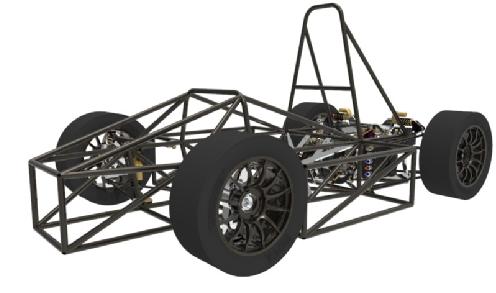 the real-world production of components into action.
the real-world production of components into action.
Following social distancing guidelines, wearing protective equipment and ensuring that workstations are properly sanitized, Warwick Racing has been able to successfully ensure that component production was able to continue safely.
They were able to focus on two critical components of the car, the front upright and the wiring harness.
Watch videos documenting the creation of these two components at https://youtu.be/IF2RFvn5pYE and at https://www.youtube.com/watch?v=mSQqVBKCD5Y
Angel Marco Ansenjo, Chief Chassis Engineer at Warwick Racing comments:
“The front uprights are the real workhorses of the vehicle: holding the front wheels in place and resisting the various dynamic loads that affect the car whilst cornering, braking and moving over bumps. As such the uprights must be one of the sturdiest and most resilient parts of the whole car.
“The process of creating an upright begins in the telemetry of last year’s car. By understanding what loads are going through the car at various points in the drive, we can better design the updated component in line with the needs of the new car. From there, the entire suspension system is digitally recreated on Autodesk Fusion 360 and simulated against a variety of stresses and load combinations to test how the suspension holds up against them. These include a hard braking scenario where the steering is put on full lock and the car hits a bump at the most loaded corner of the vehicle. This is to ensure that even in the most extreme of circumstances the part remains intact and the driver is safe.”
From here, the engineers decide on many of the intricate specifics of the upright, such as deciding on the component volume, the wheel bearings and the seals. Then, the exact material for the upright is chosen in order to allow the component to perform its job in the optimal manner. In this case, the team chose to use an aluminium-silicon alloy.
Once the volume and material are chosen, the design is run through a second phase of CAD tests to optimize the efficiency of the component and to ensure that any additional weight is shed. The engineers will then re-subject the part to digital testing and produce the toolpath which is sent to the computer-controlled manufacturing machines (CNC).
Once the part has been machined, it will be cut and measured to exact specifications and the additional bracketry will be manufactured. The wheel bearings are pressed in, followed by all the mounting hardware and the wheel hub, before the component is eventually mounted onto the chassis.
The wiring harness of a race car connects and controls various electronic components of the vehicle and ensures that wires are connected in the shortest, safest and most efficient ways possible.
Rens Bossers, Chief Powertrain Engineer at Warwick Racing comments:
“The first stage of designing a wiring harness is identifying what sensors, control units and actuators need to be connected to the circuit. On the WRe2 this contains over 50 components including, but not limited to: Battery Monitoring Systems (BMS), Inverter Data, Coolant monitors, speed sensors, steering wheel position sensors, brake pressure sensors and GPS.
“Once the components are decided on, we used smart wiring software to add all the connectors in and all the shielding and seals to protect the wiring from water and dust. The system must also be designed to ensure that it can survive the vibrations and stresses of racing without braking or compromising the safety of the car. Once the design is decided upon it is refined to ensure maximum efficiency (both in terms of cost and performance) by reducing the length of wires where possible and saving weight. “
Once the digital section of the design stage is complete, the team map out the building process using a Nailboard Wiring Diagram and begin cutting and crimping the wires to motorsport grade standards. In total there are over 5 meters of wires cut for the harness and over 200 separate connections which must be individually tested and validated. Once the tests are certified, the loom is sealed to make it both waterproof and fireproof, ensuring the elements can’t get into the circuit even in the event of a crash. Once the loom is completed, it is carefully installed and secured within the chassis.
ENDS
20 JANUARY 2021
NOTES TO EDITORS
High-res images available at:
Caption: A render of WRe2 spaceframe.
Credit: Warwick Racing, University of Warwick
Video available to view at:
https://youtu.be/IF2RFvn5pYE and at https://www.youtube.com/watch?v=mSQqVBKCD5Y
Credit: Warwick Racing
For further information please contact:
Alice Scott
Media Relations Manager – Science
University of Warwick
Tel: +44 (0) 7920 531 221
E-mail: alice.j.scott@warwick.ac.uk
WMG supports key Midlands Manufacturing report
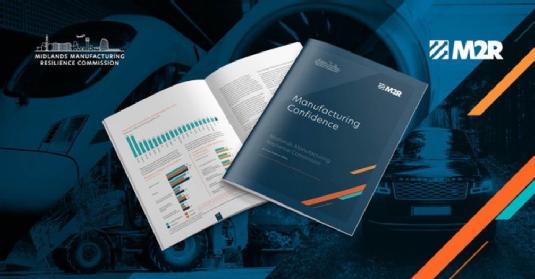 WMG Centre HVM Catapult was pleased to contribute a chapter to the recent Midlands Manufacturing Resilience Commission (M2R) report: Manufacturing Confidence.
WMG Centre HVM Catapult was pleased to contribute a chapter to the recent Midlands Manufacturing Resilience Commission (M2R) report: Manufacturing Confidence.
Led by M2R Chairman, Dr Clive Hickman, the Commission gathered evidence from a series of roundtables, surveys and contributions from some 200 participants from industry, academia and Government, including WMG’s Professor of Operations and Supply Chain Strategy, Jan Godsell.
The various discussions centred around key issues impacting Midlands’ manufacturing including skills, productivity, supply chains, leadership, innovation and finance, plus the region’s identity and reputation now and in the future.
This work culminated in “Manufacturing Confidence,” which shares the findings of those discussions, supported by a series of independently authored chapters focusing on key themes.
CEO WMG centre HVM Catapult and Director of Industrial Engagement, Professor David Greenwood authored the Manufacturing Business Support section of the report. This chapter considered the specific needs of Midlands Manufacturers, with one of the recommendations being the provision of a ‘one-stop-shop’ for business support focusing on sustainability, innovation and skills development.
An official launch event took place, virtually, on 2nd December, with presentations from Andy Street, Mayor of the West Midlands; Nadhim Zahawi MP and Hannah Boardman, Director, Advanced Manufacturing, BEIS.
Download the report here.
